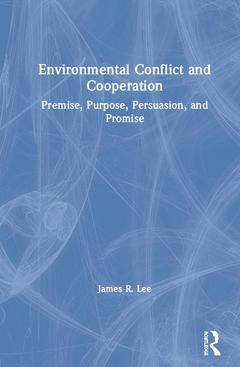Environmental Conflict and Cooperation Premise, Purpose, Persuasion, and Promise
Auteur : Lee James

Environmental Conflict and Cooperation explores the evolution of environmental conflict as a field of research and the study of cooperation as an alternative to war.
Over four key parts, James R. Lee navigates the contours of this growing field and paints a vivid framework for better understanding issues around environmental conflict and security:
? The premise of the field and its historic manifestations
? The definition and purpose of research
? The persuasions or types of environmental conflict and cooperation
? The promise of research in leading to better decision-making and to broaching new challenges.
Over the course of these parts, the author outlines the deep historic record of this discipline, arguing that it will play a key role in understanding important future trends. Utilizing a wide variety of case studies that range from ancient examples, including conflict over the Cedars of Lebanon and the role of tin in the Peloponnesian Wars, to future-oriented scenarios, including expanded island-building in the South China Sea and the global politics of geo-engineering, Lee highlights key concepts, metrics, and policy contexts that will test current understandings. He also examines a variety of research methods and provides examples of the ways in which such research can be used to inform policy improvements.
This book will draw specific interest from students and scholars of environmental conflict and cooperation, as well as researchers of environmental politics and security studies.
Part I
The premise of environmental conflict
1 The ancient roots of environmental conflict
2 An environmental conflict story
3 Why a book on environmental conflict?
Part II
The purpose of environmental conflict
4 Defining environmental conflict
5 The dimensions of environmental conflict
6 Stages of environmental conflict research
7 What is a field and why does it grow? Is there a field
of environmental conflict?
PART III
Persuasions of environmental conflict
8 Ten agreed upon assumptions
9 Pictures of the field
10 Types of cases
11 Visualizing the field through dimensional plots
PART IV
The promise of environmental conflict
12 Where do we go from here?
13 Using scenarios for problem solving
14 Future cases of environmental conflict and cooperation
15 Will the future surprise us?
Appendix A: ICE coding categories
Appendix B: Ranked data points used in plots
Index
James R. Lee isa Researcher in Residence, School of International Service, American University, Washington, DC, USA.
Date de parution : 06-2019
15.6x23.4 cm
Disponible chez l'éditeur (délai d'approvisionnement : 14 jours).
Prix indicatif 160,25 €
Ajouter au panierDate de parution : 06-2019
15.6x23.4 cm
Thèmes d’Environmental Conflict and Cooperation :
Mots-clés :
Rosewood Trees; Person’s DNA; James R; Lee; PM10 Dust; environmental conflict; Rio Tinto Alcan; environmental peacebuilding; Quadrant Q1; armed conflict; Ivory Coast; environmental security; Aral Sea; Ashok Swain; Routledge Handbook of Environmental Conflict and Peacebuilding; Mono Lake; national security; Energy Resources; trade-driven conflict; DNA Double Helix; Peloponnesian Wars; Ocean Cases; environmental cooperation; Quadrant Q3; Environmental Conflict Research; Environmental Issues; Boko Haram; Owens Lake; China Lake; Valles Marineris; Sierra Nevada Mountains; Word Cloud; Owens River; Mischief Reef; National Security Strategies



